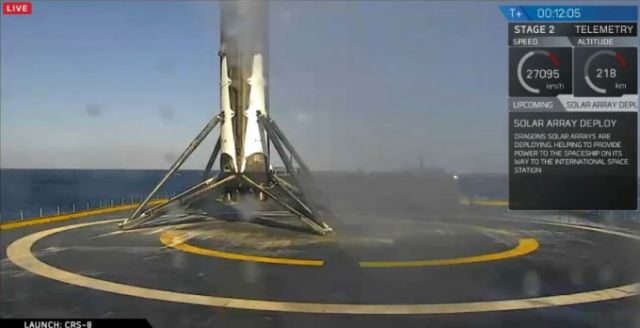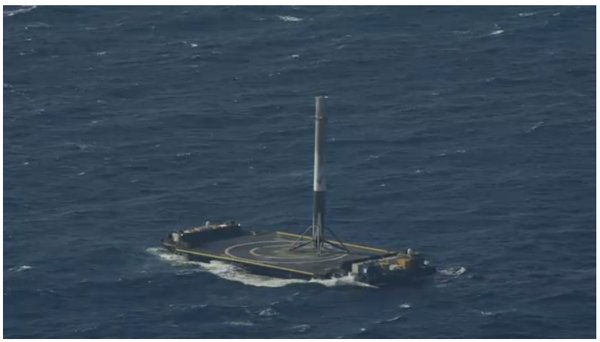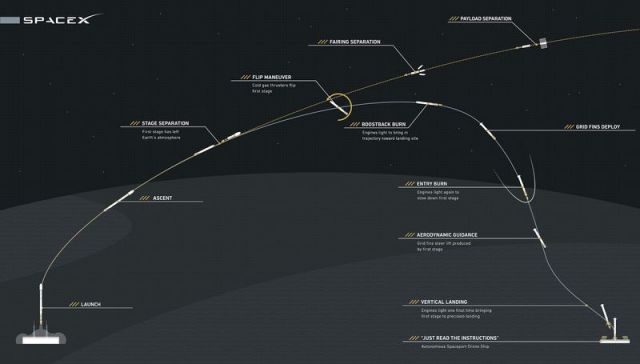

| Online: | |
| Visits: | |
| Stories: |
Successful Landing: SpaceX Docks its Rocket on a Floating Drone Ship for the First Time (Video)
(N.Morgan) SpaceX has successfully landed its Falcon 9 rocket on a drone ship at sea, in the wake of launching the vehicle into space this afternoon.
It’s the first time the company has been able to accomplish an ocean landing, after four previous attempts ended in failure.
This success is a crucial milestone for SpaceX, as it proves the company can land its rockets both on solid ground and the ocean.
For SpaceX this is the second time it has successfully landed one of its rockets post-launch; the first time being in December, when the company’s Falcon 9 rocket touched down at a ground-based landing site in Cape Canaveral, Florida, after putting a satellite into space.

Now that SpaceX has demonstrated it can do both types of landings, the company can possibly recover and reuse even more rockets in the future. Which means it could be very cost affective for SpaceX.
Being able to master ocean landings is going to be important, since that’s the type of landing SpaceX will probably conduct more frequently.
At a recent NASA press conference, Hans Koenigsmann, vice president of mission assurance for SpaceX, said the next two to three flights will involve drone ship landings.
In the future, the company expects to land one-third of its rockets on land, and the rest at sea.
What motivates SpaceX to keep focusing on these ocean landings?
A drone ship floating on the ocean is a harder target to hit than a large expanse of ground, since it is smaller and floating on moving water.
Also, all of SpaceX’s ocean landing attempts have resulted in the rocket exploding. However, landing at sea can be less tricky than ground landings, and the main reason has to do with fuel.
To make the return flight back to Earth, the Falcon 9 has to use the fuel leftover from takeoff to reignite its engines in a series of burns.
These burns help to adjust the rocket’s speed and reorient the vehicle into the right position for entering Earth’s atmosphere and then landing.
The different types of landing techniques require different amounts of fuel, though, and that revolves around how the Falcon 9 launches.
The rocket doesn’t travel straight upward into space but follows a parabolic arc up and away from the launch pad.
Because of this, the rocket has to go through a lot to conduct a ground landing.

Falcon 9 first stage on our droneship in the Atlantic after propelling the Dragon spacecraft to the @Space_Station pic.twitter.com/Cnnej7zEnt
— SpaceX (@SpaceX) April 8, 2016
The vehicle has to slow down in the direction it’s heading, completely turn around, and then retread the vertical and horizontal distance it’s covered to get back to the landing site.
This requires a lot of extra fuel.
Ocean landings aren’t as complicated as that. SpaceX’s drone ship can position itself in an ideal place to “catch” the vehicle on its more natural path back to Earth.
That decreases the distance the rocket needs to travel, as well as the amount of fuel needed to maneuver the Falcon 9 for landing.
Since the SpaceX missions use up a lot of fuel, performing a ground landing may not even be possible.
Rockets that launch heavy payloads or go to a high orbit need extra speed during the initial ascent, and extra speed needs more fuel.
Those Falcon 9s that have to reach extra high velocities don’t have as much fuel leftover for the landing.
That’s when the drone ship is the best — if not only — option for recovery.
The main goal of landing these rockets is to help save SpaceX money on launch costs.
Right now, most rockets end up destroyed or lost after they launch into space, meaning entirely new rockets must be built for each mission.
SpaceX hopes to recover as many rockets as possible to cut down on cost of creating new vehicles. The Falcon 9 costs $60 million to make and only $200,000 to fuel.
If a recovered rocket doesn’t need too much updating and refurbishment between launches, reusability could eliminate a good chunk of that manufacturing cost.
SpaceX President Gwynne Shotwell expects reusable rockets to bring down launch costs by about 30 percent, according to Space News.
That would make the company’s vehicles whichh would make for an even cheaper option for clients than it already is.

References:
http://www.theverge.com/2016/4/8/11392138/spacex-landing-success-falcon-9-rocket-barge-at-sea





I got a bridge to sell you in North Dakota if you believe this.
All of this is a complete waste of money and proves absolutely nothing. Here is why…. ItsHisStory.com/globe
Lol, they are practising landings, fifty years after landing on the moon.